“I think that’s one of the best games I’ve ever seen. Quality and drama. Just unbelievable tennis.”
— Colin Fleming, TennisTV Commentator after the 5-4 game in the third set
Novak Djokovic defeated Carlos Alcaraz 5/7 7/6 7/6 in 3 hours and 50 minutes to clinch his 39th Masters 1000 at the Western & Southern Open in what was the longest match in tournament history. With the win, Djokovic now levels the H2H at 2-2 with Alcaraz.
First Set
This match began in oppressive conditions, with temperatures in the mid-30s making things very lively and difficult to control the ball. It didn’t take long before Alcaraz deployed the forehand drop shot, playing it perfectly here by sending it in the opposite direction of Djokovic’s split step.
Alcaraz used the wide serve on the deuce court and his kick serve wide on the AD court to stretch Djokovic and open the court early on, with the speed and bounce of the Cincinnati conditions reminding me of Madrid—the scene of their first-ever meeting.

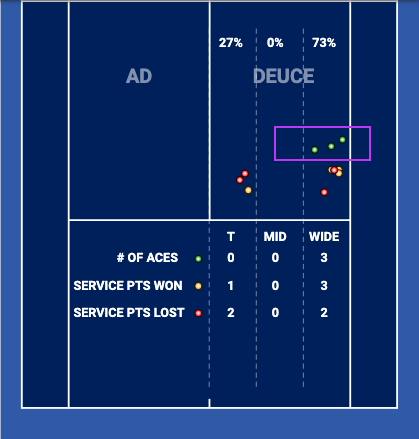
The first few games were everything we expected: Alcaraz looked to impose his game on the Serb with his usual melange of power and finesse, while Djokovic looked to contain it with his trademark depth and change of direction. It didn’t take long for the quality to emerge: look how deep both keep their rally ball while changing direction, even at end-range:
Djokovic wasted no time securing the break on the very next point, again finding a way to neutralize Alcaraz’s power before unloading on a forehand from high and deep.
Not to be outdone, Alcaraz found his own end-range magic in the very next game, giving Djokovic a taste of his own medicine on his way to breaking back:
And it was from 4-3 when Djokovic started to look affected by the heat. The footwork and shot selection was shoddy, the backhand shield was flaky. That isn’t to say that there weren’t moments of brilliance:
But it was definitely a fading Serb.
At 5-5 Djokovic gift-wrapped a slew of break chances, misfiring on two regulation backhands and dragging a short approach forehand wide. He managed to wrestle the score back to deuce before again shanking a fall-away forehand off the bottom of the frame. But Alcaraz’s aggression on the third break-point gave no hint or notion that he was content in waiting for errors, overwhelming Djokovic with that Tyson-esque hook forehand:
At this point, it looked as though Alcaraz’s intensity of style had worn down his older foe in tough conditions. Why does that sound familiar? The young Spaniard sealed the set emphatically with an open-stance down-the-line backhand winner.
Djokovic went off-court for a uniform change.
“They come out of nowhere sometimes those forehands. Taking opponents by surprise.”
— Tennis TV Commentary

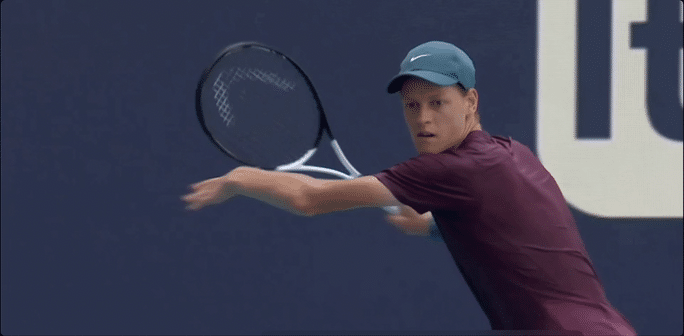
Set 2
In terms of quality, this set was pretty poor. Djokovic was still seemingly dazed and confused in the heat, and Alcaraz appeared to be lulled into a false sense of security when up a break and two games from the finish line.
At 1-1, Djokovic threw in three double faults in a row. Colin Fleming:
“I mean, to look at him here, five faults in a row, you even wonder, is he even going to be able to finish the match?”
Alcaraz secured the early break. Djokovic looked ill as he consulted with physios and doctors:
Alcaraz must have been feeling bulletproof by this point. He’d weathered tough moments all week—every match had gone the distance, and he’d saved a match point in his semifinal against Hurkacz—and now it seemed as though the title was going to be won in a similar anticlimactic fashion to their Roland Garros semi-final.
Whether Alcaraz got complacent or simply lost focus only he knows; playing a wounded player can be difficult. Whatever the reason, Alcaraz threw away his lead in the 4-3 game with a flurry of errors. It certainly brought a second wind to Djokovic, who started to find the balls of his feet and the precision in his swing, upping the aggression inside the court:
Djokovic would go on to save a match point in the tie-breaker, finding a big serve plus one combo at 5-6. To his credit, Djokovic found ways to come forward and play more aggressively with his forehand throughout much of the business end of set 2.
Yet, in typical Djokovic fashion, he won the set having endured a bruising rally where he refused to concede an inch or an error; he is rarely first to blink in big moments. Alcaraz swatted a backhand crosscourt into the net, and just like that, we had a third set. Djokovic could only manage a subdued celebratory shake of the racquet; a far cry from his usual spirited celebrations, but he had shown Alcaraz, and the crowd, that he wasn’t going anywhere.
Set 3
Having ticked over to 7 pm the court was now fully shaded. It still wasn’t exactly comfortable.
Djokovic had the first break chance at 2-2, where Alcaraz seemed intent on saving it in the most playful fashion possible:
At 3-3, Djokovic again found himself with two break chances, but both went missing. While the quality of the match had been lacking in large passages of play so far, the drama of this match was starting to create quite an atmosphere. Both players seemed to feed on this energy, hitting and running with renewed intensity. Here’s Alcaraz giving his forehand a heat check, only to catch the net tape:
And on the next point, Djokovic would finally seal the break, with Alcaraz netting another crosscourt backhand. He would hold and then look to break the Spaniard in the 5-3 game.
From this point onwards the match entered into that rare zone where players and crowd alike were completely absorbed in what was unfolding; the importance of each point had been magnified in the wake of such a seesawing affair, yet the players had endured so much already that there seemed to be no nerves left, leaving us with two men who refused to give in to their fatigue. This had the added effect of allowing both players to play in a flow state, producing the most incredible points in the biggest moments. Here is Alcaraz saving a match point that will give you goosebumps:
Alcaraz would go on to hold having saved two match points. He would save two more on Djokovic’s serve before breaking for 5-5. The Flashscore itself is a picture of pressure and torture for both players:

I mean, Djoker going 1/11 on break points in this third set also tells you a lot (Alcaraz would save two more after this screengrab, naturally):
And of course, once all breaks have been squandered and all that is left is the frustration of missed chances, Djokovic unloads on a forehand that makes you realize just how within himself he usually plays:
It’s 3:30 am as I write this, so to be brief: Alcaraz holds. Djokovic holds. Go watch the damn thing again if you can. In the tie-breaker Alcaraz again blinked in the 1-0 point.
More precisely, he tapped out of a 29-shot rally. Here’s the end of it.
It’s no shame. After 3 hours and 30 minutes of this tennis, in this heat, with these stakes, I have no idea how these blokes don’t tap out sooner. I just don’t understand why he tapped out with a Fabrice Santoro-inspired double-fisted forehand. Why not just slap your regular forehand in a blaze of glory, Carlos?! Perhaps the hand cramp was worse than he let on.
That has to be the strangest shot selection I’ve ever seen, given the stakes and the moment.
Perhaps it was a glimpse into the state of mind of Alcaraz. After this unique attempt, he then tried to SABR a forehand return (unsuccessfully), then two points later again came forward on Novak’s serve (and picked up a ridiculous volley). He did manage to get to 4-4 in the tiebreaker, but my impression of this third set is that Alcaraz was never playing with the percentages in his favour when exchanging from the baseline.
I still think that he can be overly aggressive—especially when wide to his forehand. I still think he could chip more forehand returns—especially on premium points. I still think that his flat backhand can get loose and leak errors —especially against the best backhands (Djokovic/Sinner/Zverev).
None of this is to say that he can’t and won’t make tactical changes ahead of the US Open next week. If we’ve learned anything in the last few months it’s that Carlos Alcaraz is a quick study on the tennis court. Armed with the experience of Juan Carlos Ferrero in his coaching box, it will be fascinating if these two manage to meet again in Flushing Meadows.
It must be said that Alcaraz spent a lot more time on court this week coming into the final, and coupled with the conditions, perhaps those decisions in the closing stages of this match were just a reflection of mental fatigue. There was also a hint of hand cramp again late in the third as he stretched it out. It seems that in hot conditions, with the ballistic mode of play he employs, it might be worth working on some game management as he matures; finding ways to conserve energy—both during and between points–so that he can bring his best level (mentally and physically) in the late stages of these matches and tournaments. Otherwise, this kid just seems to fly too close to the sun.
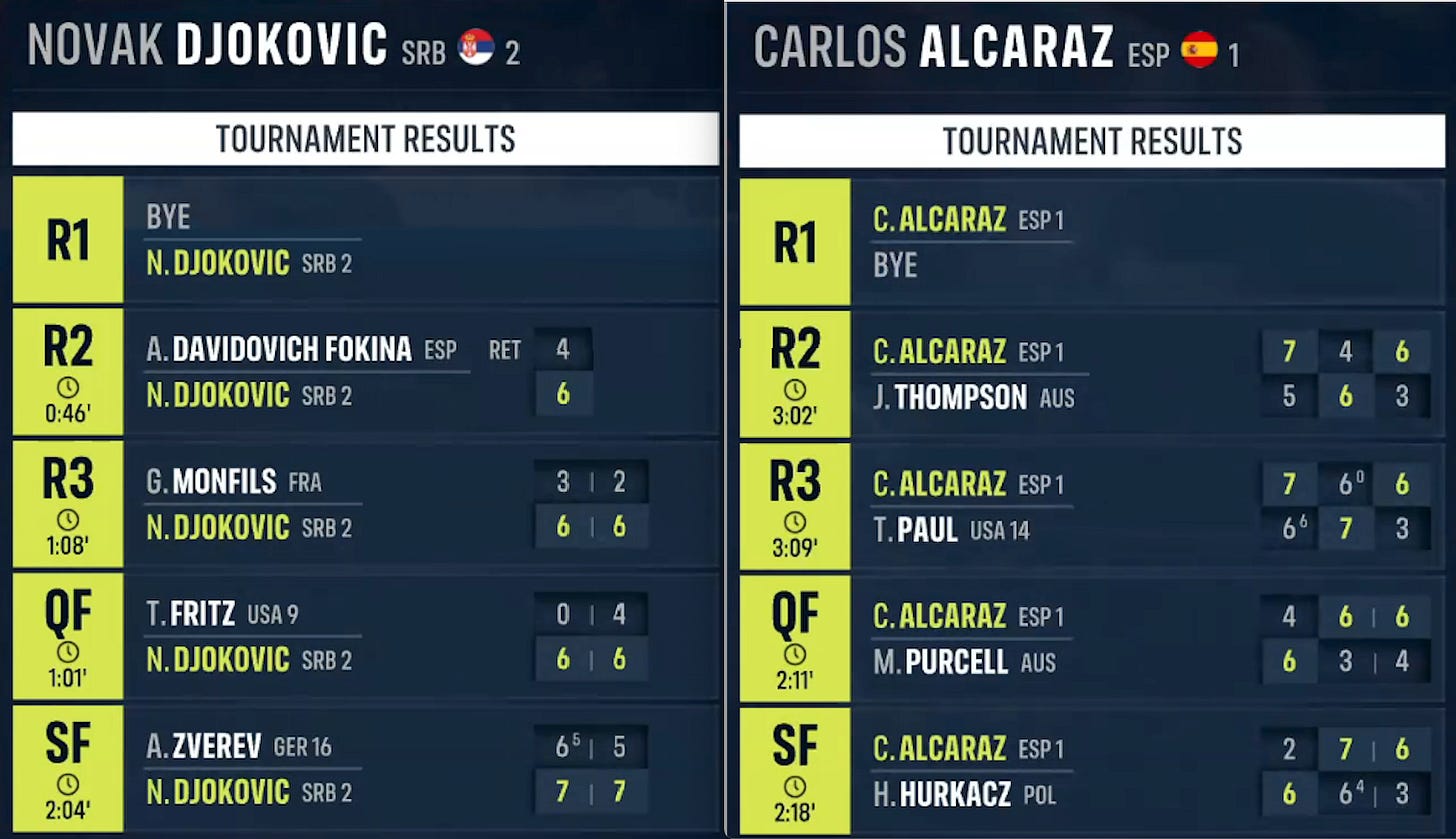
What the players said:
Djokovic: “Just overall, one of the toughest and most exciting matches I was ever part of and these are the kinds of moments and matches that I continue to work for day in day out. I was never in doubt that I can deliver the 'A' game when it mattered the most and [I am] just thrilled.”
Alcaraz: ”It's amazing playing against you, sharing the court with you, learning from you. This match was really close, but I learned a lot from a champion like you. So congratulations to you and your team.”
It was a phenomenal spectacle in the third set: a perfect advertisement ahead of next week’s final slam of the year.
The US Open kicks off on Monday, August 28. I’ll be back with a draw preview on Sunday.
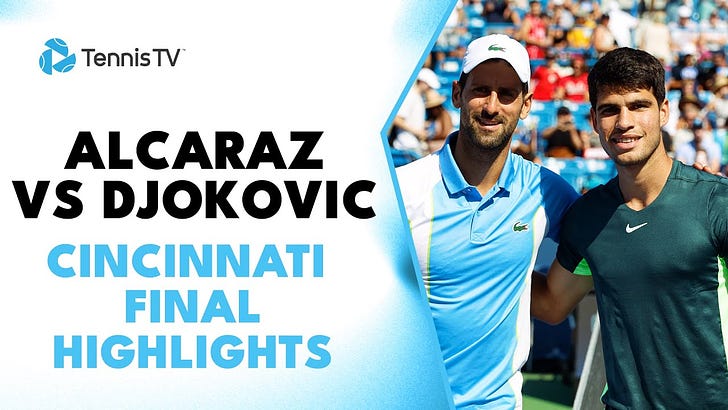


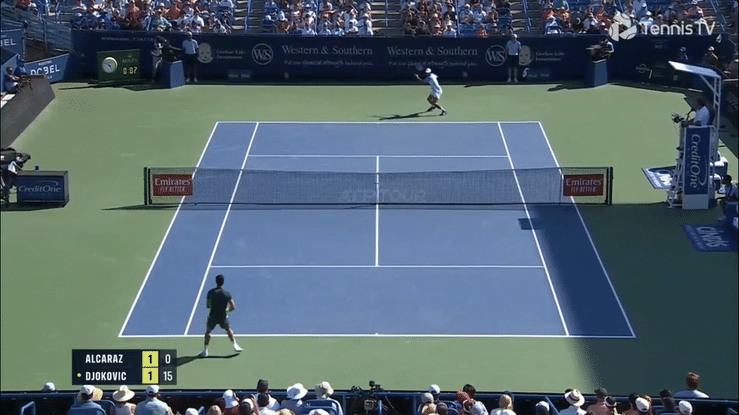
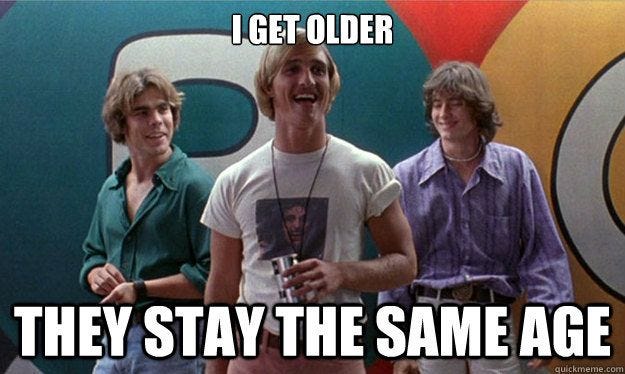




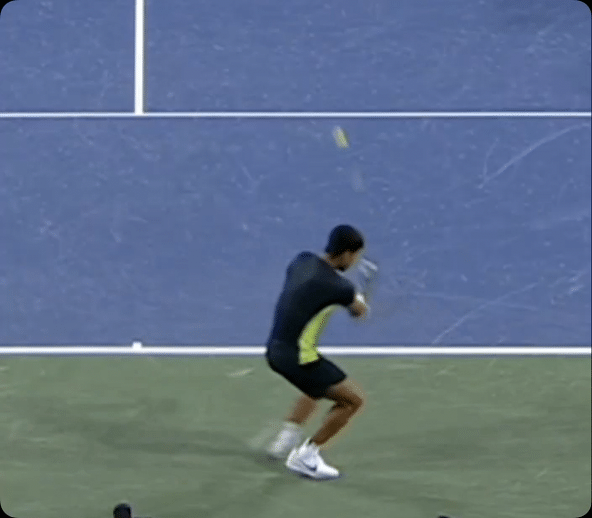
Hi, could you kindly elaborate more on what is a Ferris Wheel vs. Merry-go-round forehand take back?
In the context of this match, I see the criticism of Carlos flying too close to the sun. Personally, I hate when he rushes the second serve with a SABR. He's too powerful to do that and can rarely control that shot.
But the bigger issue with Carlos, at least in Cinci and Toronto, is the first serve. The % was terrible and until yesterday entirely too predictable. Flat bomb followed by kick. Tommy Paul and Hurkacz were all over this. Ben Shelton, too, who pushed Alcaraz in his only straight set victory of the past two weeks.
Here are the low point % moments for Carlos' first serve over the past two weeks:
Ben Shelton - 58% (Toronto)
Hurkacz - 59% (Toronto)
Jordan Thompson - 55%
Purcell - 55%
Hurkacz 1st set - 42%